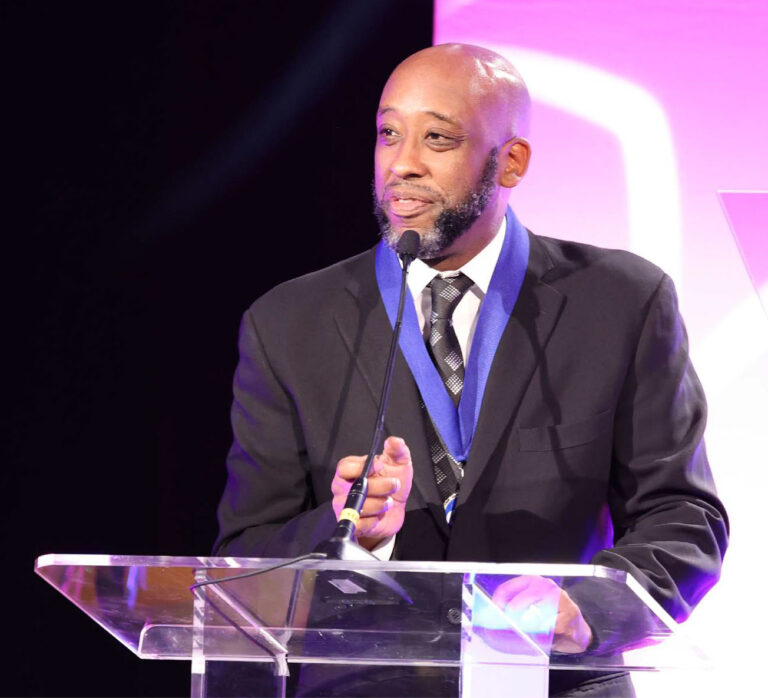
The following is the Presidential Address given by Roosevelt Mosley at the 2023 Annual Business Session at the CAS Annual Meeting in Los Angeles.
When I was growing up, my father told me that his prayer was that God would let him live long enough to see me be successful. Because my dad was a pastor of a Baptist church, my young mind assumed that he must have special status with God, and therefore I could expect my dad to be around for a long time. In the fall of my senior year of high school, however, my father suffered a massive stroke. While he survived the stroke, he was never the same. He was moved from the hospital to a nursing home, and it was in this nursing home that he passed away – one week before my high school graduation. The funeral was two days before I graduated. As valedictorian, I had to give the valedictory address.
As a teenager who lost his hero, this was a difficult time. As I processed his death, one of my initial reactions was that God had not answered my father’s prayer. He didn’t get a chance to see me graduate from college. He wasn’t able to see me get married. He didn’t see his grandchildren. He didn’t get to see my career grow or me become CAS president. But it wasn’t until many years later, once I had children of my own and watched them grow and develop, that I realized God had answered his prayer. My father held on until I had been named valedictorian of my high school graduating class. And while he didn’t get to experience any of the future successes with me here on earth, he had seen enough to know that I was going to be successful.
As I stand here today, reflecting on the last two years of leadership of my leadership journey, the last 30 years of my career and the 109 years of our Society’s existence, I can’t help but wonder what heights the CAS will reach that we can’t really conceive of yet.
The CAS was founded in 1914, and there have been a number of successes that we have achieved as an organization over our 109-year history. One of those successes, as you have heard about and will continue to hear about during this meeting, was reaching 10,000 members this year. As I have reflected on this milestone over the past few months, it got me thinking. I wonder if the original 97 founding members even could have envisioned achieving a milestone like this. So, I went back and did a little digging. I actually read through the first presidential address in 1915 by I. M. Rubinow. While a lot of the address was about setting up the society and all that had taken place in the first few months, I did find a telling quote in Rubinow’s speech. It was from a publication called the Weekly Underwriter, an insurance newspaper published at the time. “There is no reason why this society (known as the Casualty Actuarial and Statistical Society) should not be as valuable to the casualty business as the Actuarial Society of America (now the SOA) has been to that of life insurance.” It was clear that while they may not have been thinking specifically about 10,000 members, the foundation had been laid to achieve this milestone based on the value that had been recognized by the insurance industry. Just like my father, even though I. M. Rubinow did not see results, maybe he knew that the foundation laid would ensure the Society would be successful.
As I stand here today, reflecting on the last two years of leadership of my leadership journey, the last 30 years of my career and the 109 years of our society’s existence, I can’t help but wonder what heights the CAS will reach that we can’t really conceive of yet. Maybe it is a numerical height – crossing some new member threshold. Maybe it is an industry height – there could come a day when the property and casualty insurance industry is not the predominant industry we serve. Maybe it is a global height – could there come a day when the majority of CAS members are not located in the U.S.?
The truth is, I don’t know what greater heights the CAS will achieve. Just like my father did not know exactly what heights I would achieve. Just like I.M. Rubinow did not know what greater heights the CAS would achieve. But what I am confident of is that as a society we will achieve new heights. My confidence comes from reflection on the past two years of leadership, and I believe that we have the right people focused on the right areas that will get us to the right place.
The progression of our Society from where we are now to where we will go reminded me of a book that was written almost 30 years ago by Jim Collins called Built to Last. It is a companion to his book, Good to Great, where he talked about the characteristics of companies that turned good results to great results. In Built to Last, he talks about turning great results into enduring great companies. I would argue that our history has demonstrated a progression of good on the way to great, and I believe that greatness can endure. In Built, Collins describes nine characteristics of great companies that endure. In the interest of time, I will only highlight four and use those to illustrate with examples from the past year that demonstrate why I believe the CAS is on the way to new heights.
First, enduring great companies don’t tell time, they build clocks. When you tell time, that is valuable at the moment. When you build a clock, it ensures that those who come after you will be able to tell time after you are gone. Enduring great companies are not built on great ideas or because of great leaders: They are built on enduring processes that will last long after those who built the processes. The CAS will reach new heights because we have and are building processes that will endure. You can see this, for example, in the Admissions Transformations Plan. The outcome of this plan will not just be a transformed basic education pathway, but a process that will ensure that our basic education remains the gold standard in the realm of property and casualty actuarial. Another example of this is our current effort to modernize the way we govern ourselves. One key outcome is a process by which our governance processes will continually be evaluated against best practices. As we build clocks, it will ensure that we maintain our leading position as P&C actuaries.
Second, enduring great companies are about more than profits. They find their organization’s purpose and build the core ideology. As a professional association, our focus is not profits. You could point to other metrics, such as number of members or surplus ratio. Regardless of the KPI, the point is still applicable. The goal is not to maximize the KPI; the goal is to be the best at fulfilling our organization’s purpose. If we do that well, the results will come. We have been celebrating the 10,000-member milestone, but we realize that the goal has never been membership growth. The goal has been to achieve our envisioned future, which is that actuaries should be sought after for their ability to apply analytics to solve insurance and risk management problems. As we succeed in achieving this, membership growth will continue.
The CAS Board went through a strategic planning process in 2019–2020 that did just this, and it laid the foundation for us to begin going through this process again, as the Board has discussed the strategic plan over the past year. This effort starts with the key important first step — understanding our “core purpose,” understanding our “why.” While our “why” will not change every time we review the plan, the tactics on how we fulfill our purpose may. The process is established and is being solidified to continue even after all of us are gone. And I can tell you that your volunteer leaders are fierce about remaining true to our core ideology.
Third, great enduring companies have cult-like cultures and a cult-like adherence to the culture. Every time I get a chance to speak to students, candidates and new members, I talk about the culture of the CAS as being one of its primary key attributes. I brag with pride every chance I get about the fact that 30% of our members volunteer in some capacity with the CAS. Other organizations only dream of that kind of participation. And this level of engagement means that the research we produce, the continuing education events we host and the quality of our operations are second to none.
I have seen numerous examples of this engagement from our members over the past two years, and I truly thank you for that engagement. Examples include:
- Feedback regarding what you liked and didn’t like so much.
- Passion around DE&I.
- Faithful observers of our board meetings.
- Volunteers engaging with university students.
- Members pushing us into developing areas such as climate risk and bias in rating.
I.M. Rubinow likely had no idea what we would be facing in 2023. Thirty years ago, I couldn’t have predicted the things we would be facing now. The explosion of data, machine learning and AI, automated vehicles, the internet of things, climate change, cyber liability — the list goes on and on. In 1915 when Rubinow talked about the need to apply actuarial science to the emerging area of automobile liability, I don’t think he contemplated a time when the car would not require a person to drive it. Similarly, there are things that, sitting here today, are not even on the radar. But that’s OK. We don’t need to know what those things are. Because if we ensure that our organization is built to identify, analyze and react to trends as they develop, then we can be confident that the CAS will be built to last, and reach milestones we can’t even envision yet.
Before I conclude, I have some personal thanks. Being able to fulfill the duties of this role does not happen without the help of a ton of people.
First to my family: Yashica, Bria, Michael and Brooklyn. To those at Pinnacle: the partners, team and Michelle Jones. To those at the CAS: Board, Executive Council, Victor Carter-Bey, staff and Laura Stout. Lastly, to each member. It has truly been an honor and a privilege to serve you this past year, and I truly do hope that I left things a little better than I found them.











